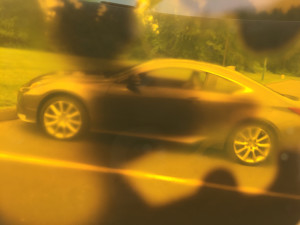Third Age Suit Points to Greater Safety Technology Needs
Posted on Mar 17, 2022 in Safety | Comments Off on Third Age Suit Points to Greater Safety Technology Needs

Normally driving a 2015 Lexus RC 350 is an exercise in automotive enjoyment. On one hot day recently, I found it extremely difficult. I had trouble seeing. My movements were largely restricted, and my hand was shaking. I was less confident in my ability to safely drive.
While it sounds like I was drunk, I wasn’t. I was encased in Ford’s Third Age Suit. It is designed to significantly reduce mobility when worn. It helps designers and engineers create future vehicles with the needs and limitations of the elderly in mind. It also does a great job of highlighting how crucial current safety technology will become as you age.
As Ford told me, people 85 years and older represent the fastest growing demographic of drivers—nearly doubling from 1.76 million in 1998 to 3.48 million in 2013, according to the U.S. Department of Transportation’s Federal Highway Administration. A study by the National Institutes of Health found that the fatality rate in car accidents for these octogenarians is nine times greater than for those under 70.
The Third Age suit (here’s a video on it) significantly decreases mobility thanks to restrictive knee and elbow braces and weighted feet that make swinging your legs into the car as well as operating the gas and brake pedals difficult; fingerless gloves that limit hand movements, as well as cotton gloves that desensitize your touch, which is a consequence of diabetes; and acoustic earmuffs that suppress your hearing. The latter made me turn up the radio and almost yell to be heard.
The most impactful aspect of the suit, though, was the impairment glasses. Donning the “glaucoma” glasses, I drove around a community-college parking lot. Foolishly I felt like I could drive okay if I drove slowly. That demonstrates the risks older drivers are willing to take in spite of significantly impaired vision. (It might also prove the need for regular eye testing of people over the age of 75.) It could have been disastrous to hit the open road with this visibility impairment.
Another telling feature was the cervical bandage that limited neck movement to the point that I couldn’t look over my shoulder to see behind me. I couldn’t have confidently backed out of a parking space without a rear camera. It also made me appreciate how important rear cross-traffic alerts, found on the 2016 Ford Edge and increasing numbers of new vehicles, can be for older drivers.
Constantly improving lane-departure warning technology will also help similarly encumbered drivers. It will warn them if they miss vehicles in their blind spots. New technology on the 2016 Hyundai Tucson goes further and warns if a vehicle up to two lanes away is trying to enter the space you want to occupy. Lane-departure warning systems will also prove effective in helping older drivers with reduced grip on the steering wheel stay in the proper lane with tactile reminders that they might be drifting.
Probably the most important technology for older drivers—and one not directly hyped by Ford as part of the Third Age Suit—would be adaptive braking technology that anticipates a crash in front of you, pre-energizes the brakes for more force, and, in some cases, starts braking for you. It will greatly help older drivers with diminished response times get into fewer accidents.
I’ve seen what my driving abilities will be like in about 20 years thanks to Ford’s Third Age Suit. That makes me crave autonomous driving even more.




